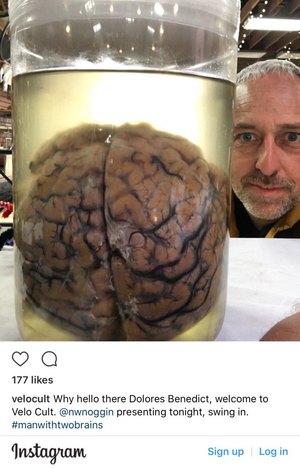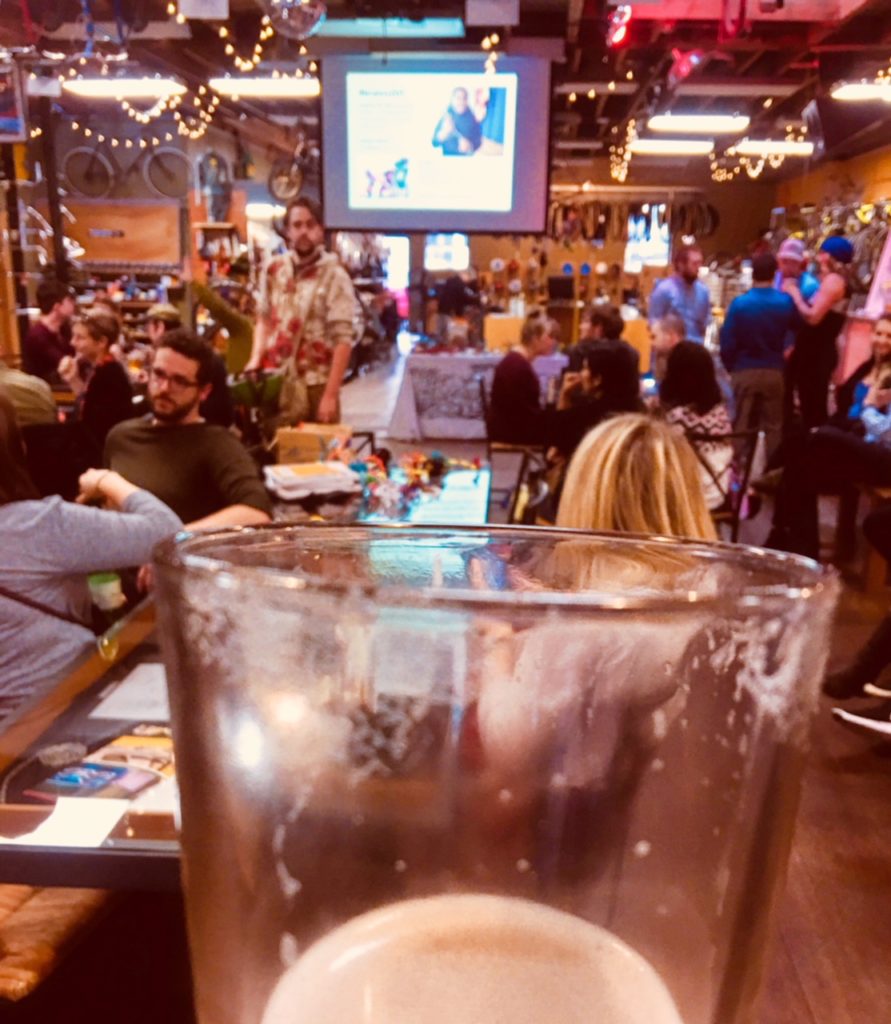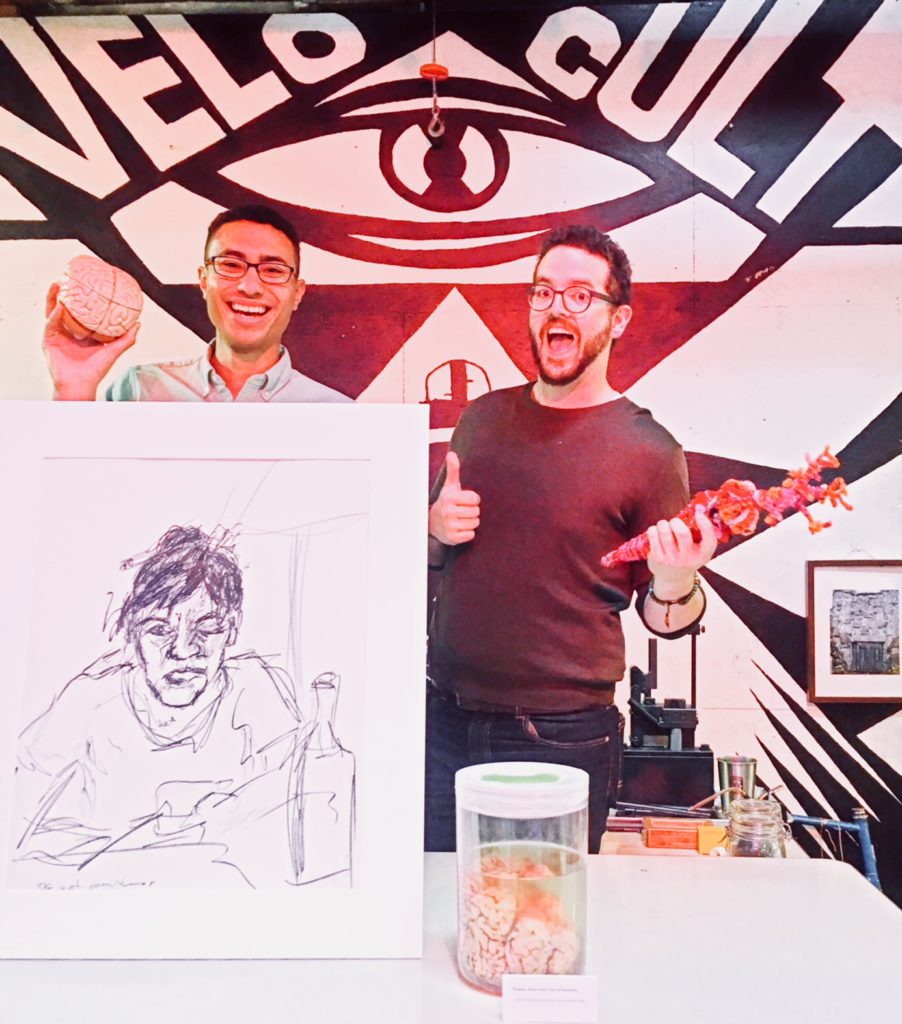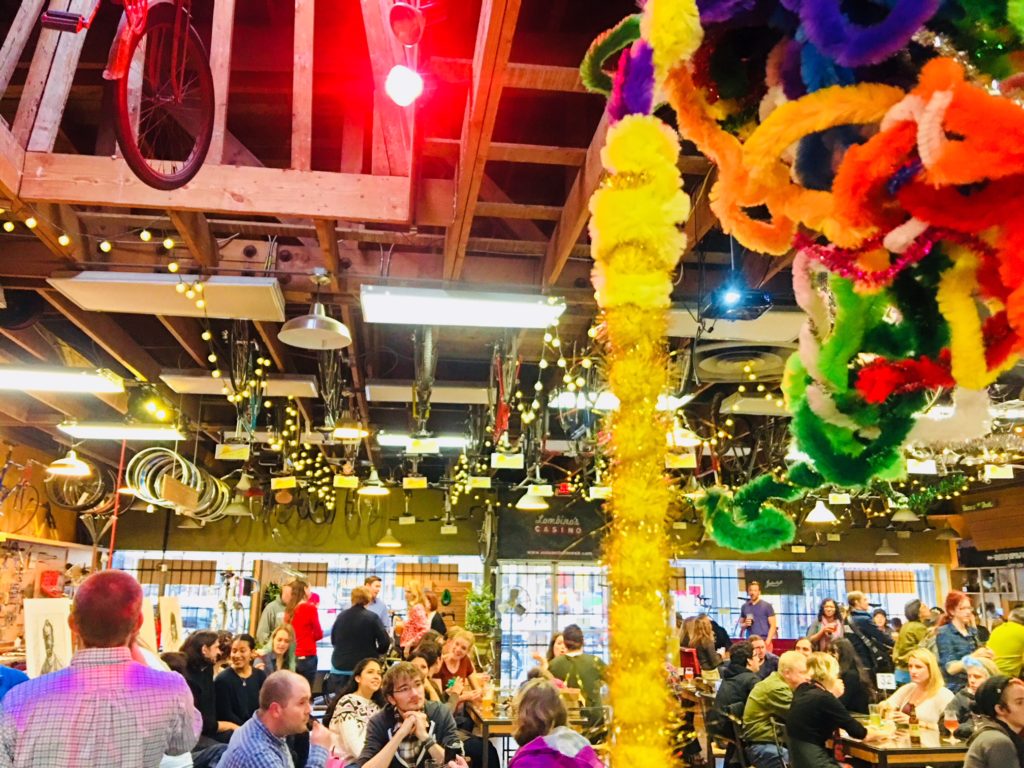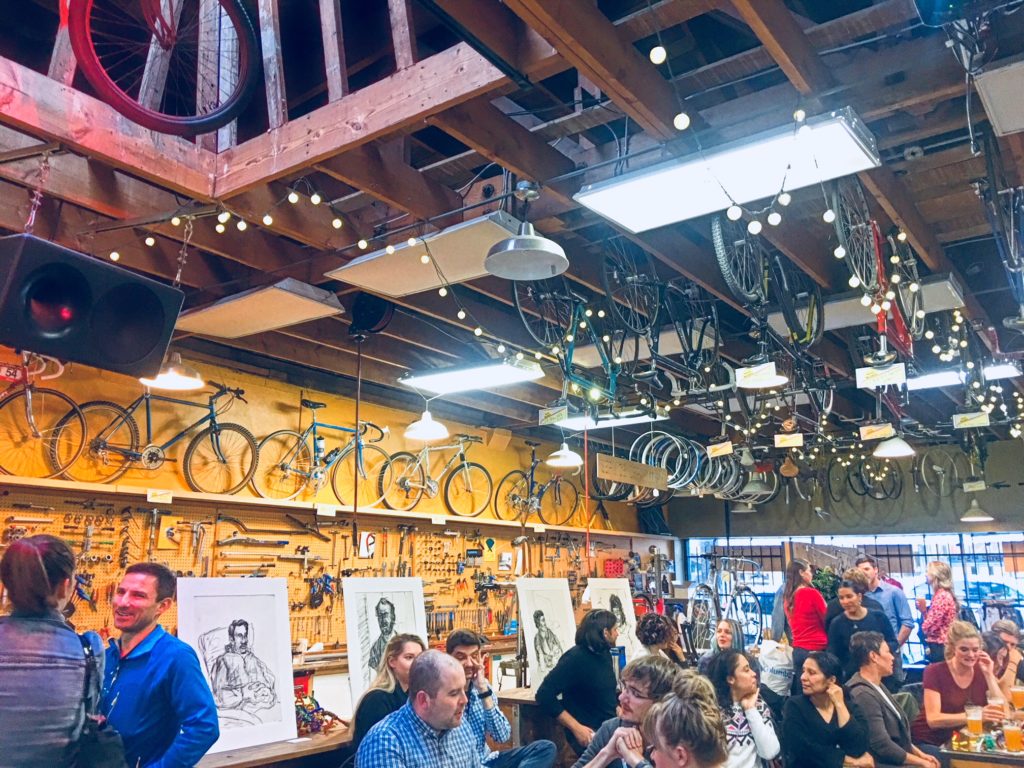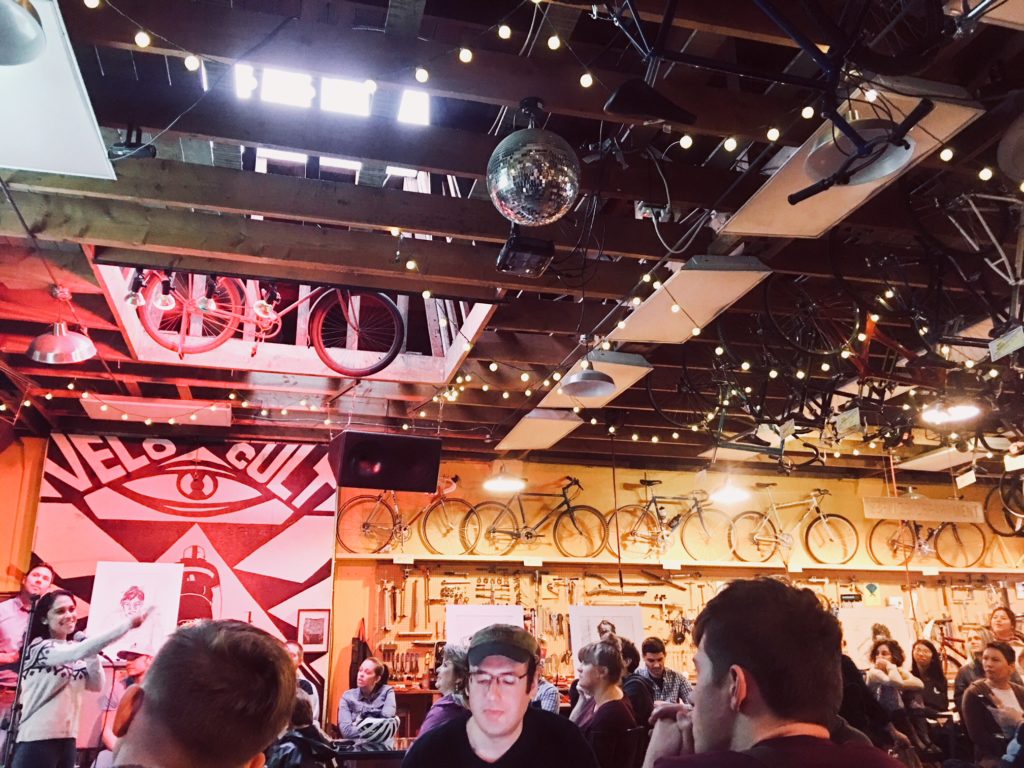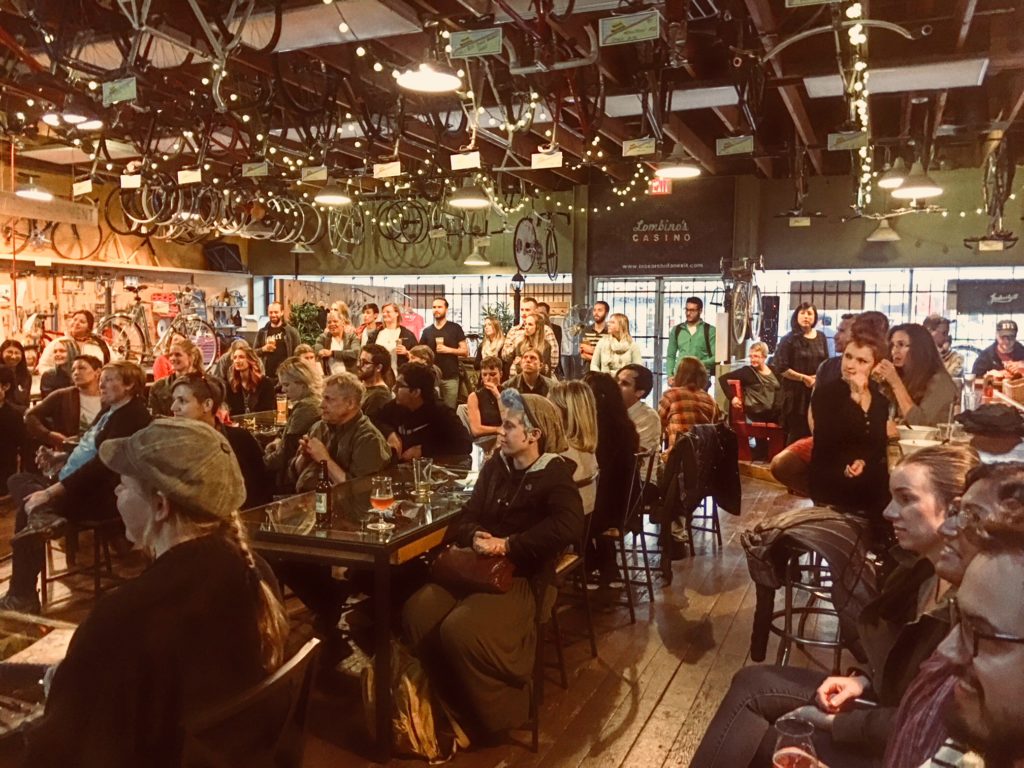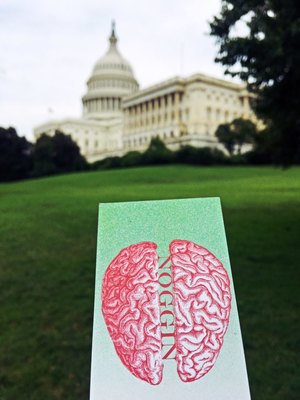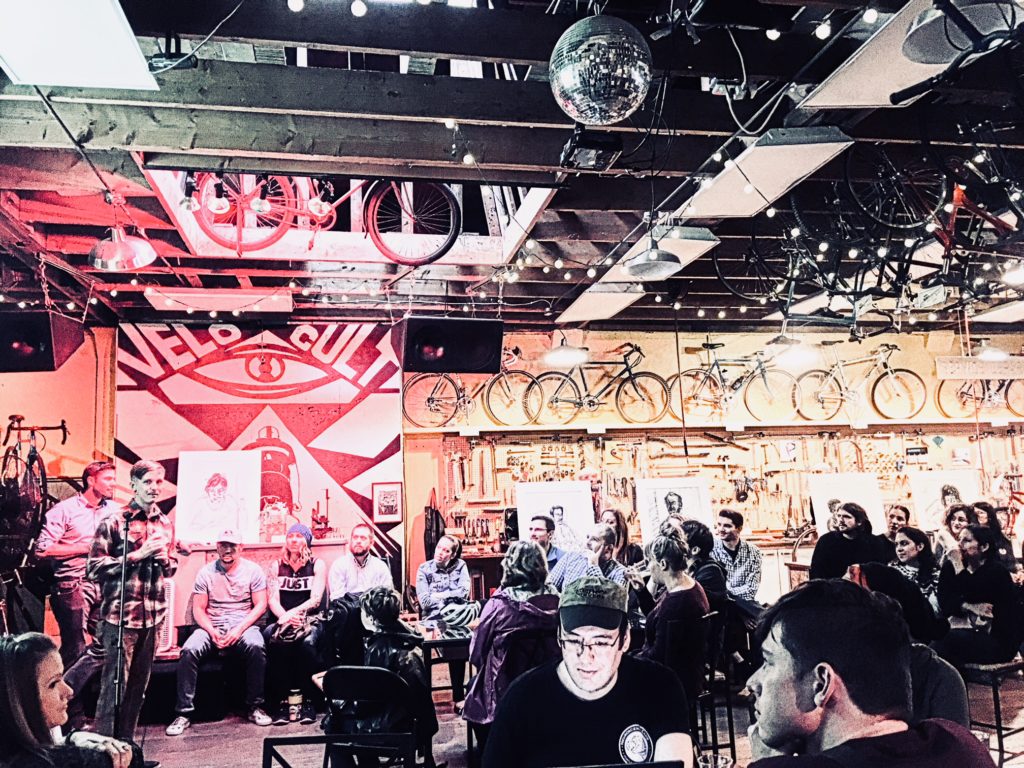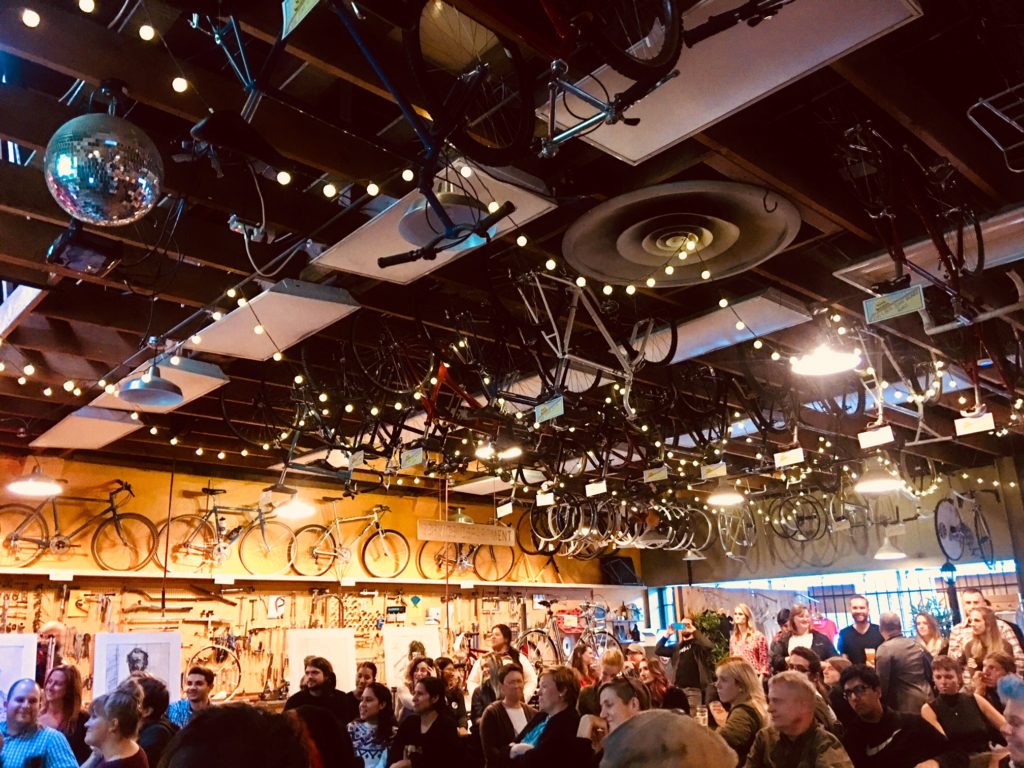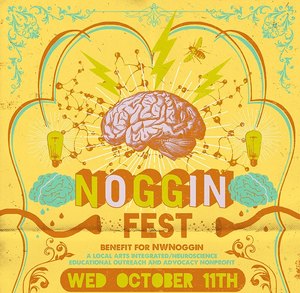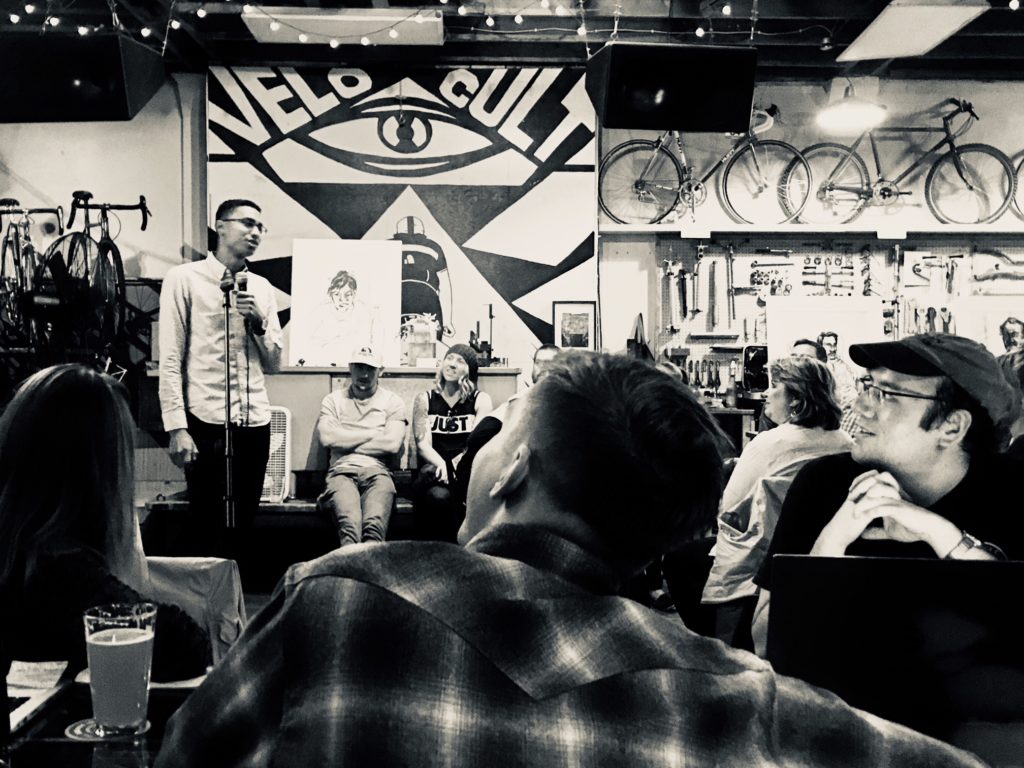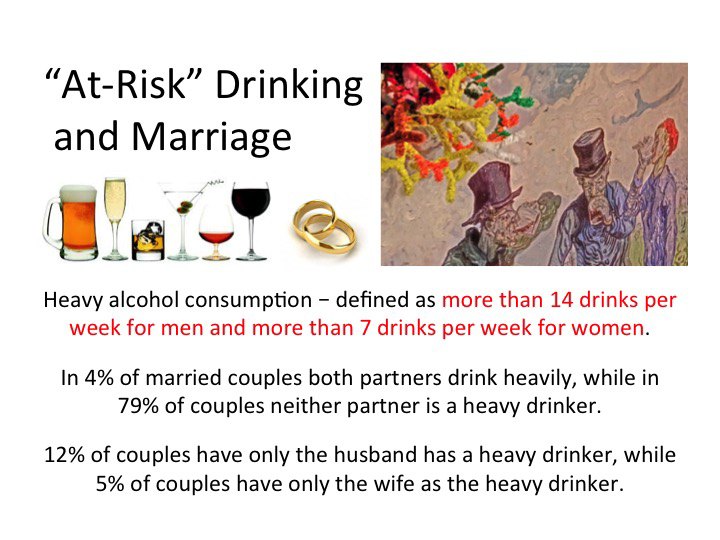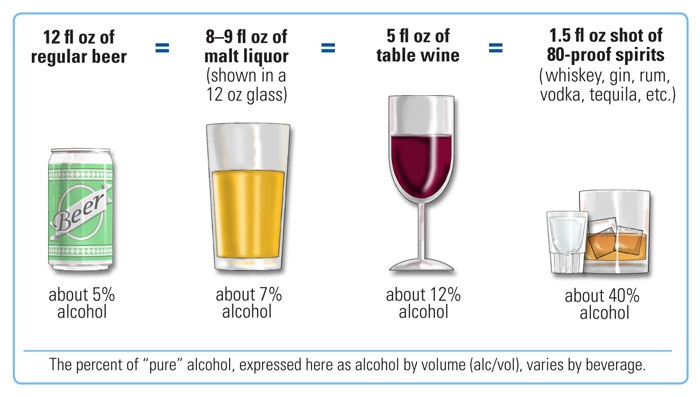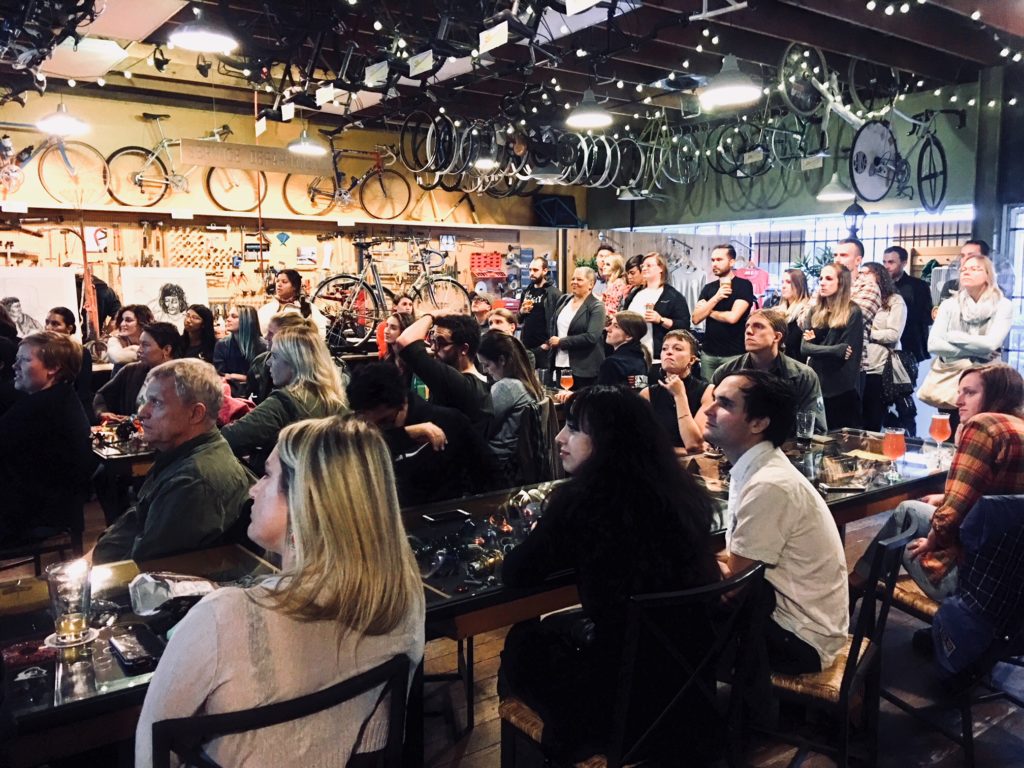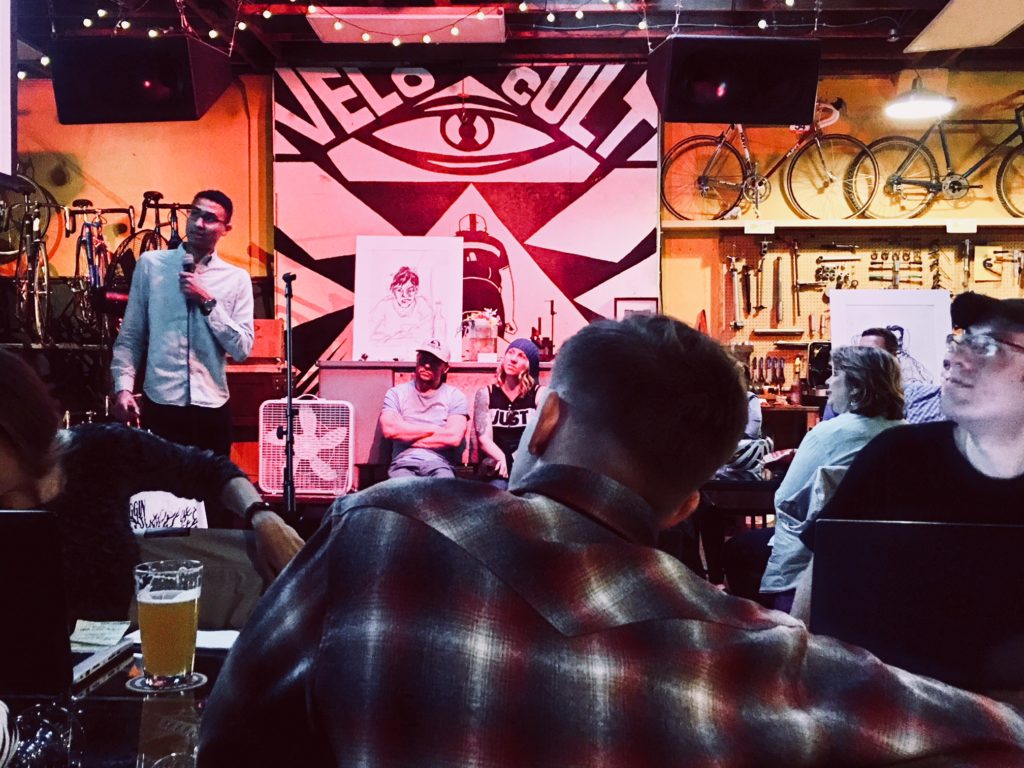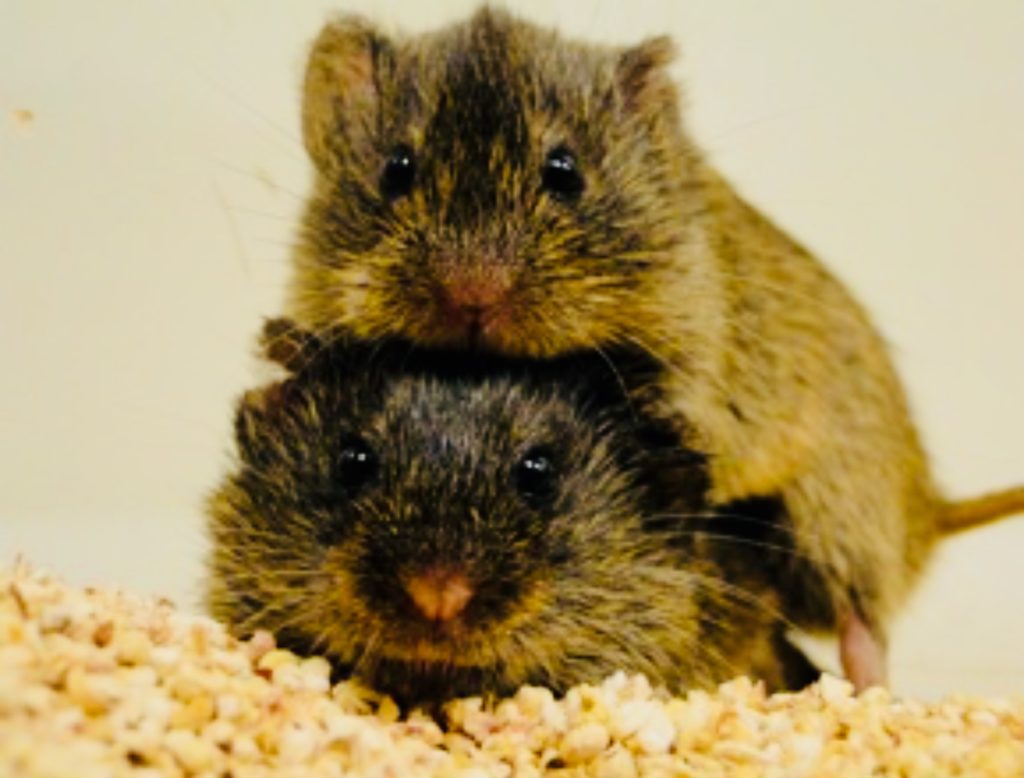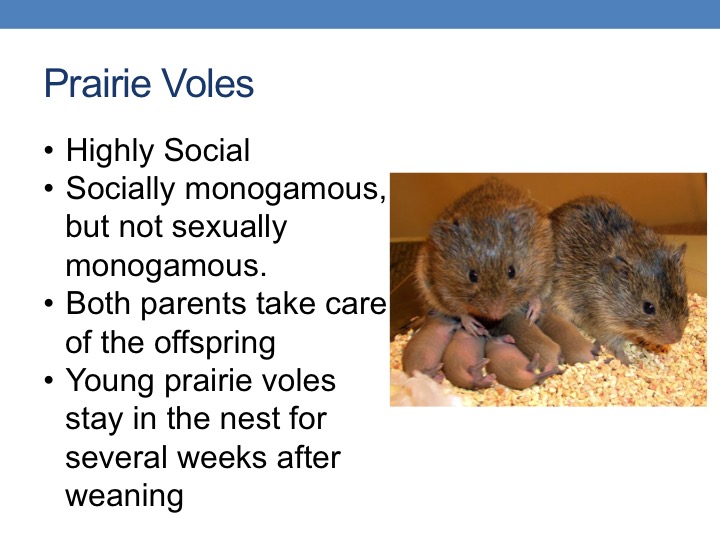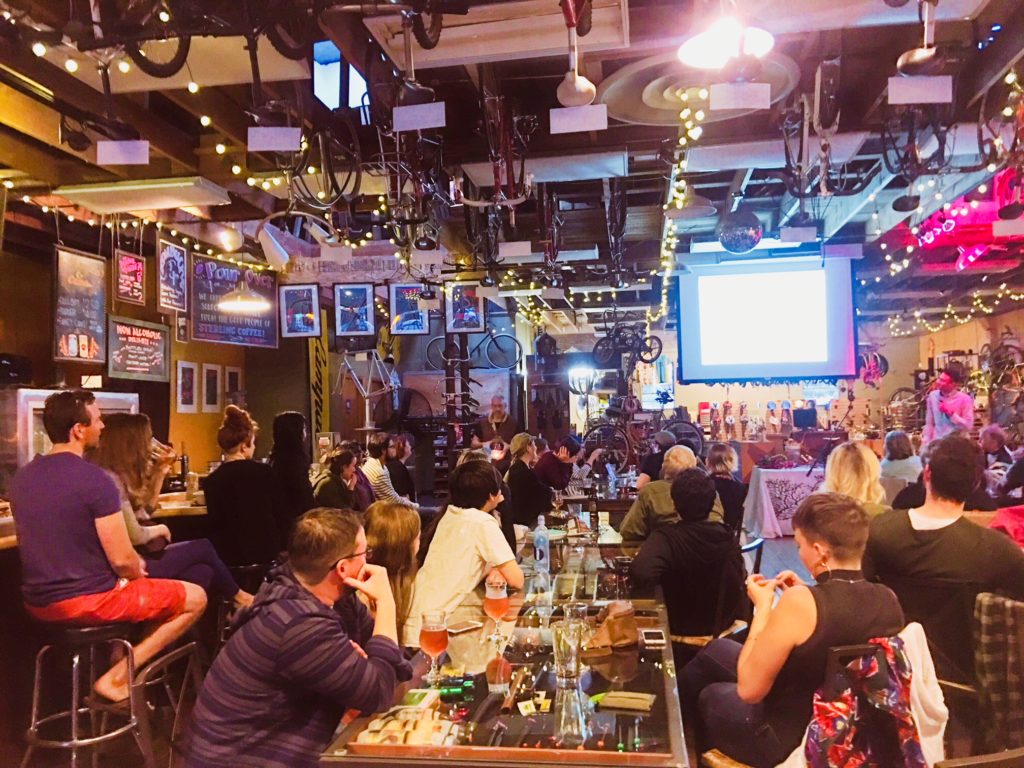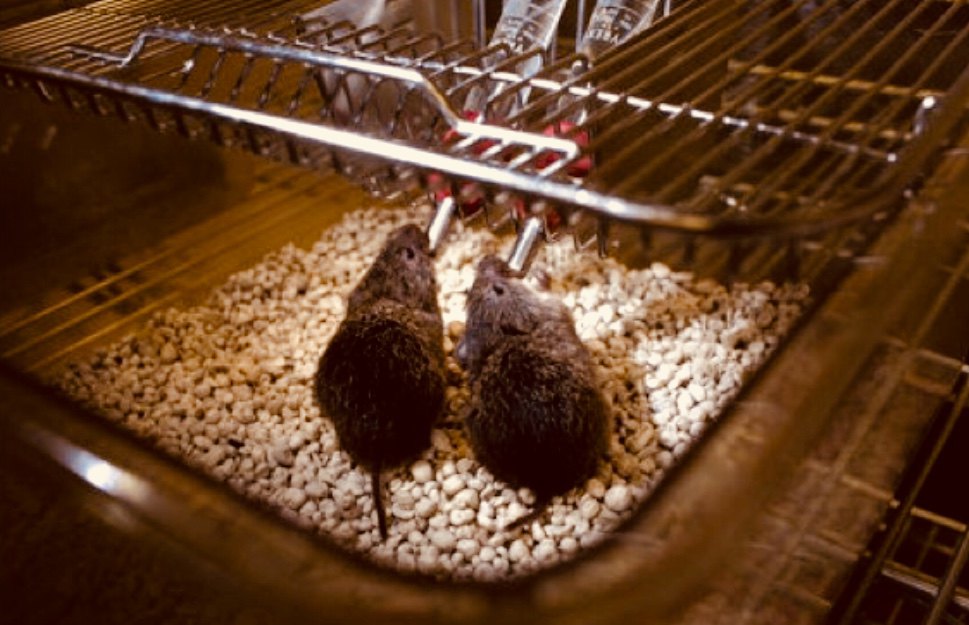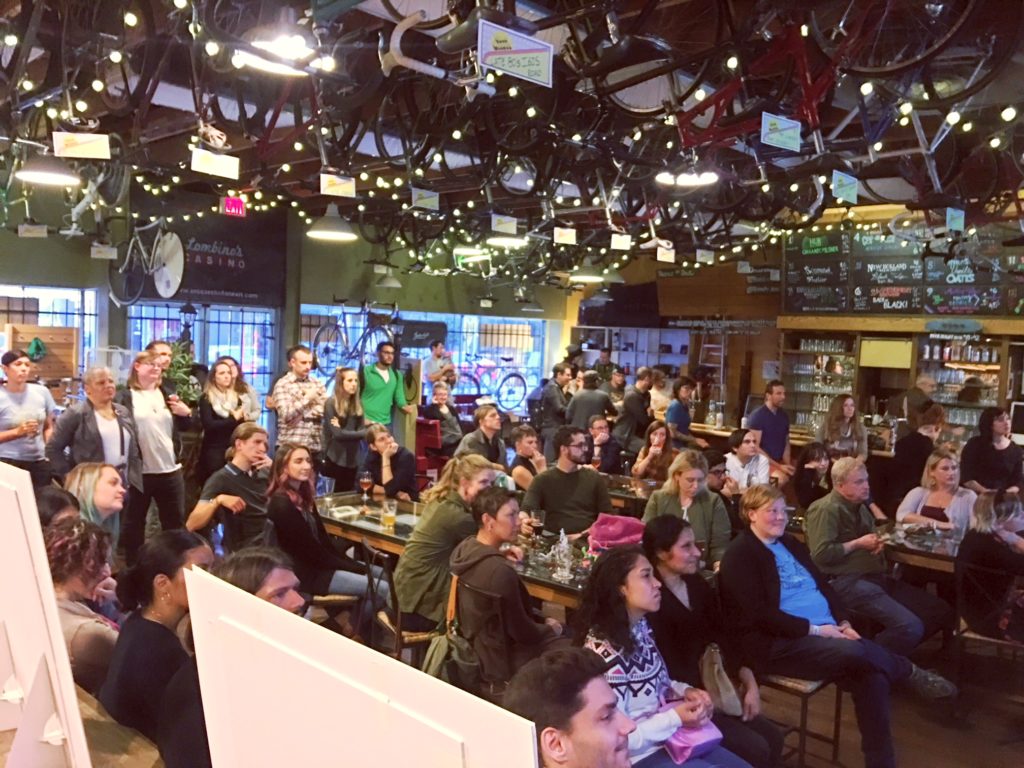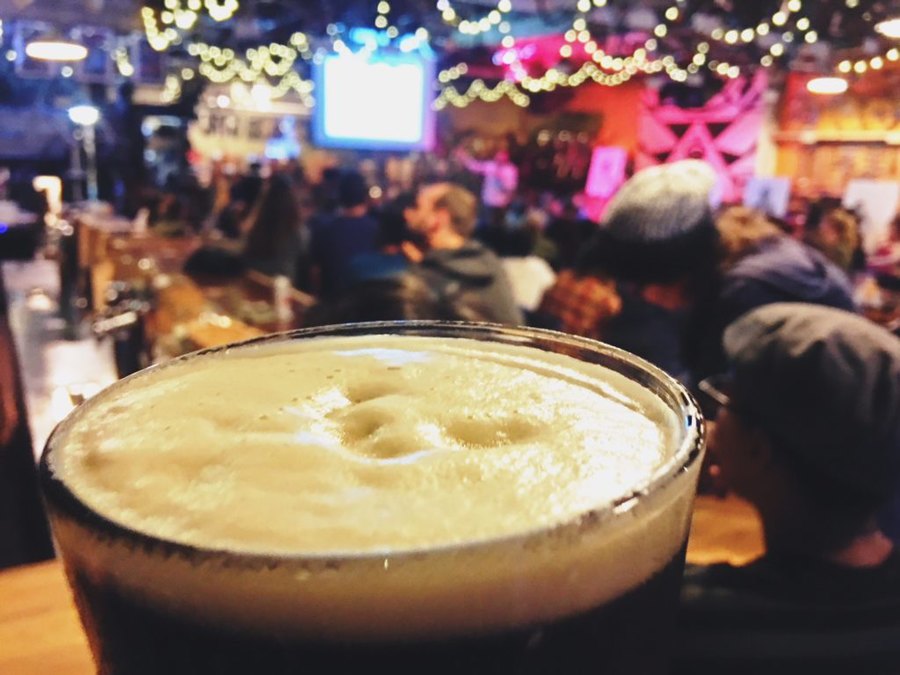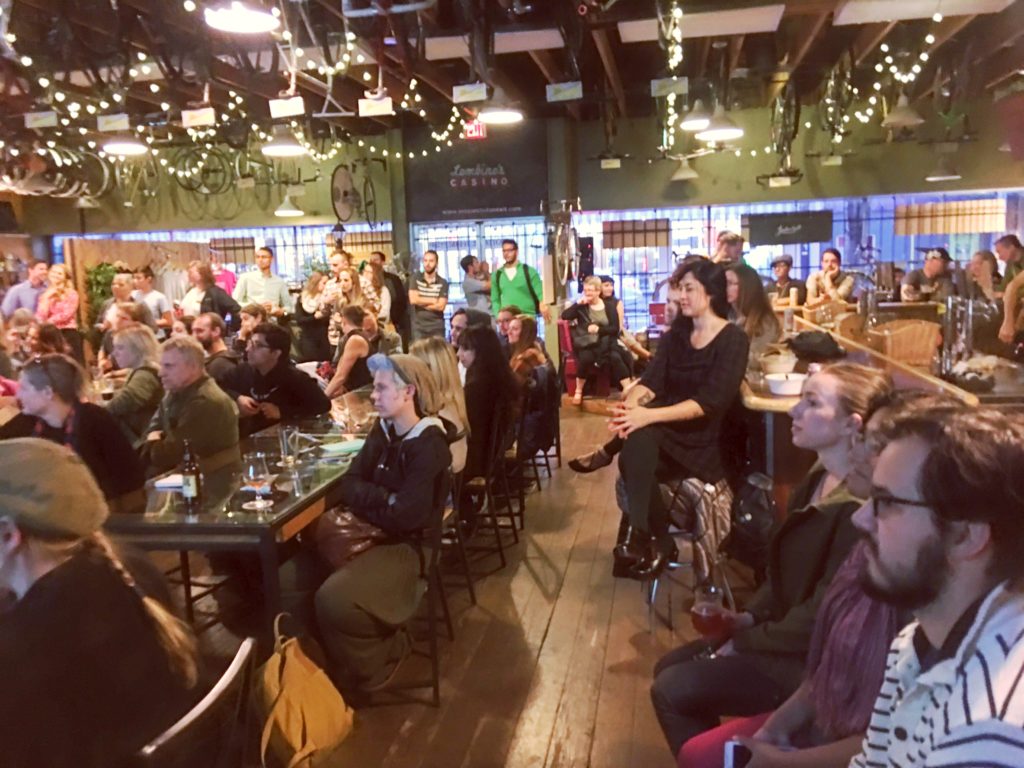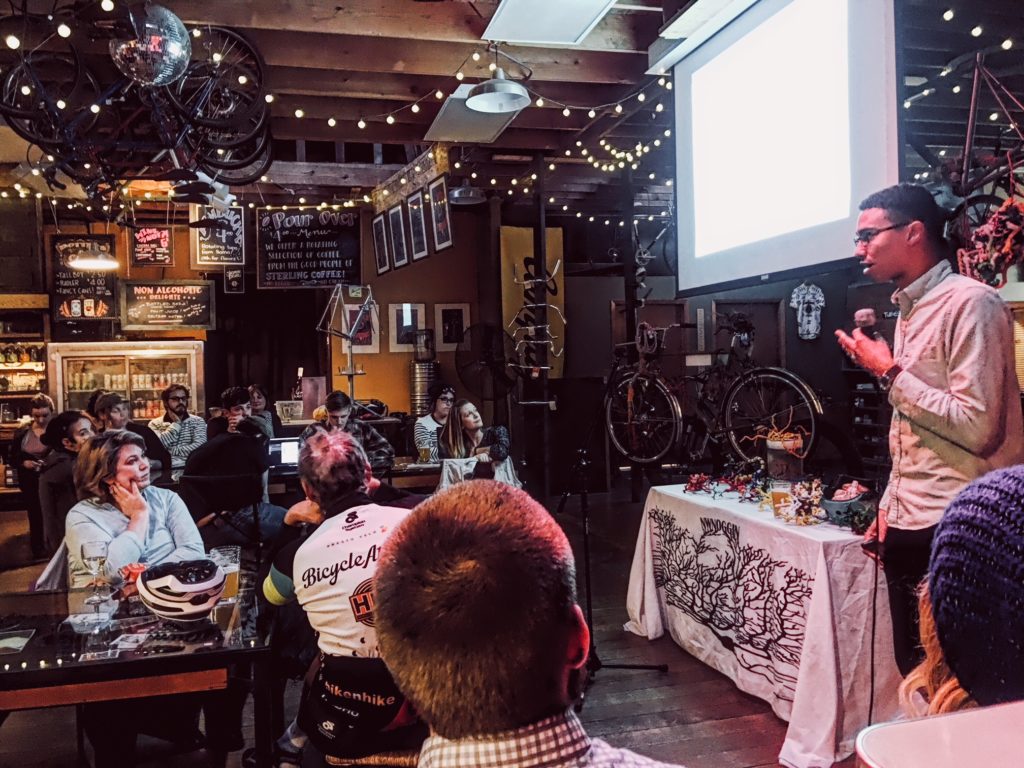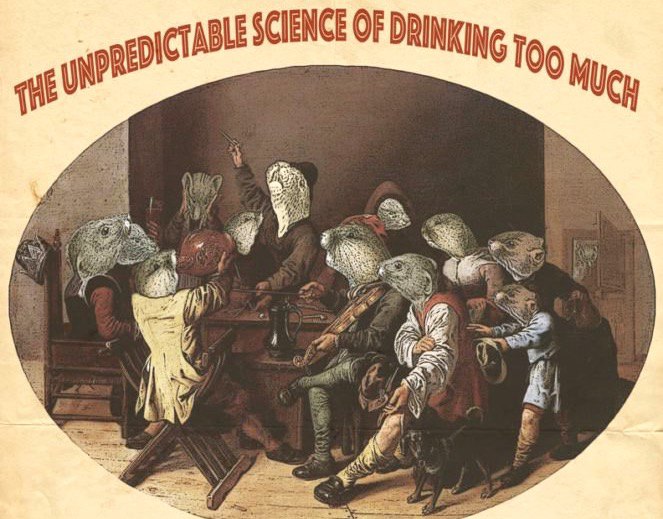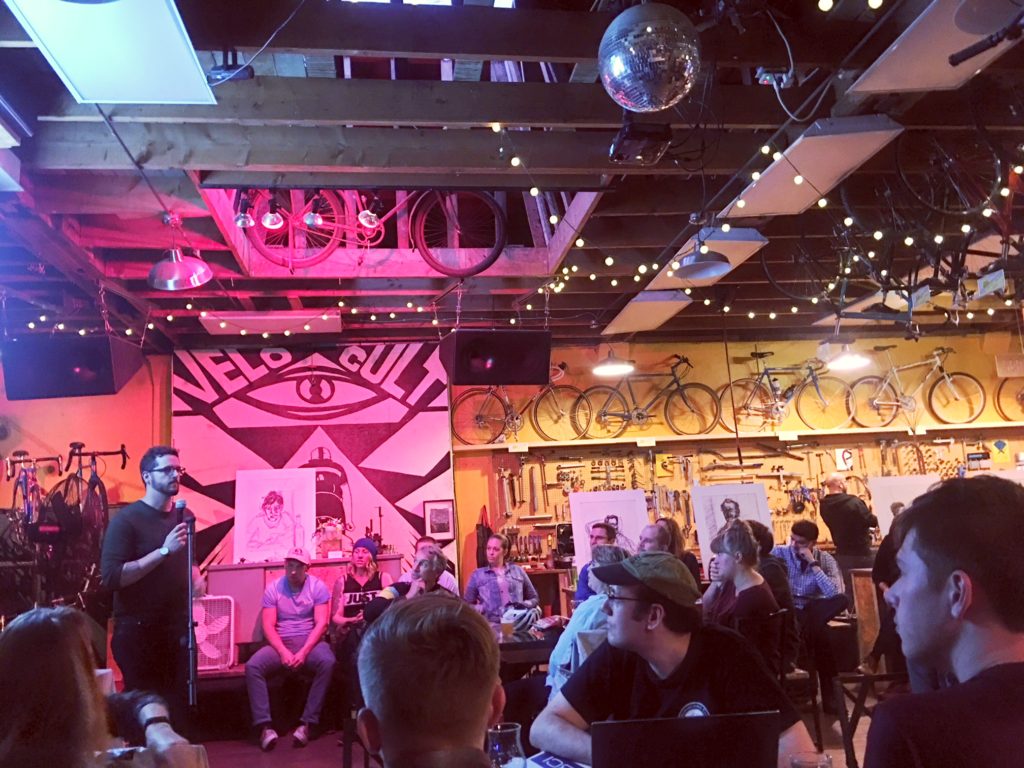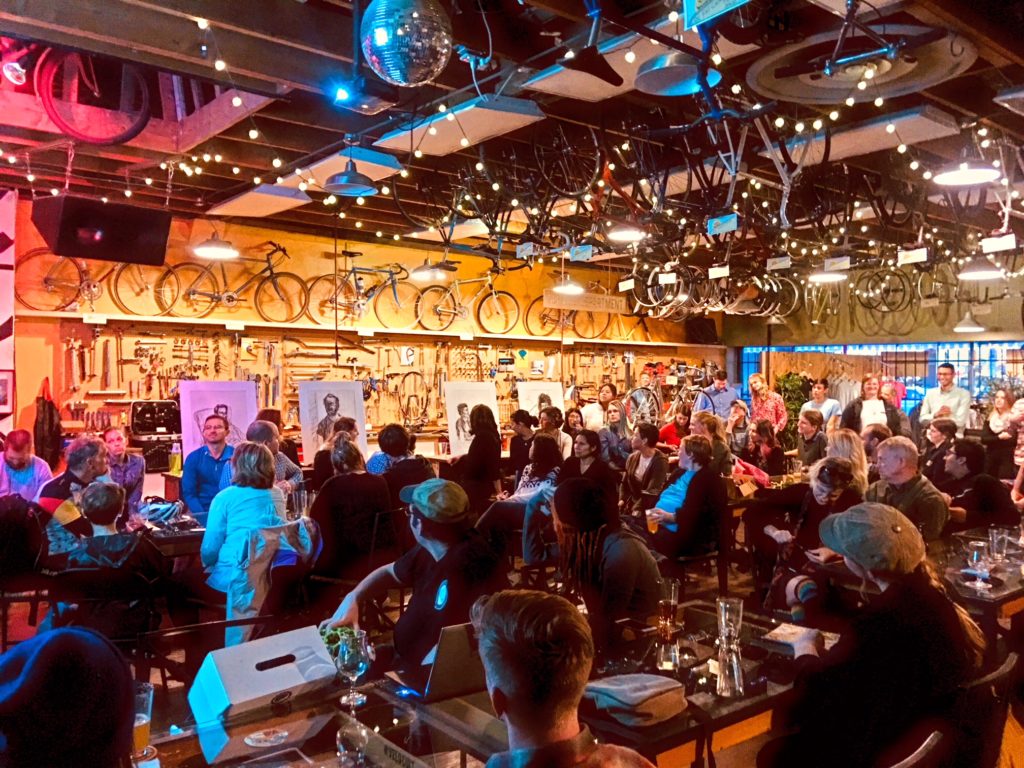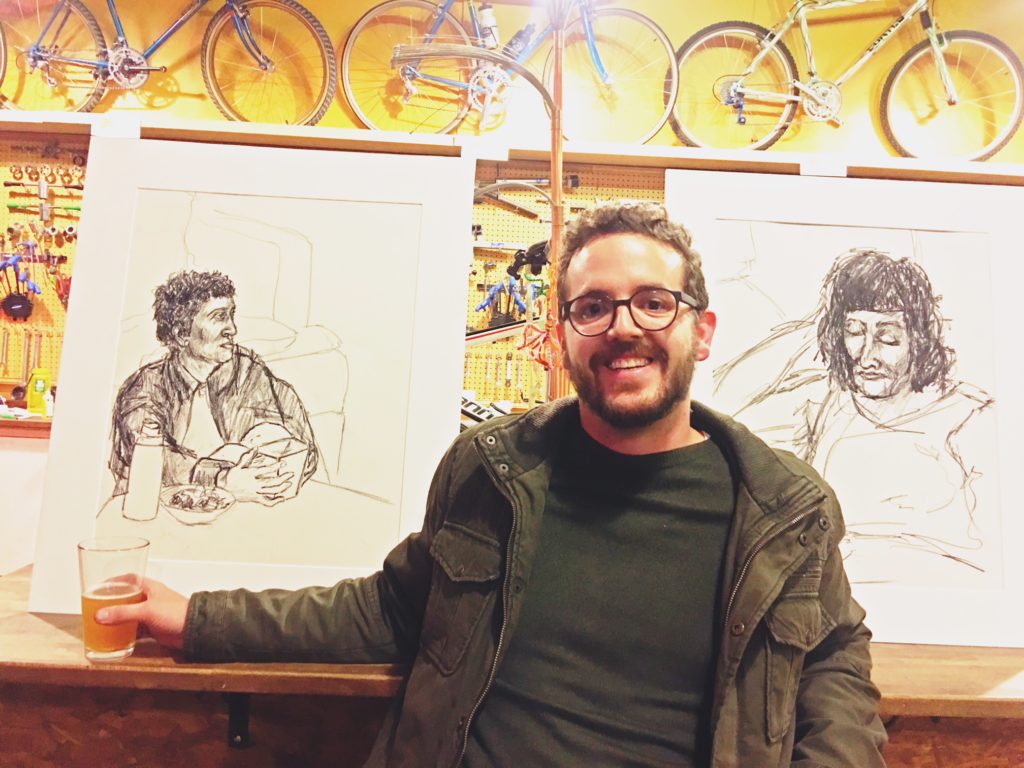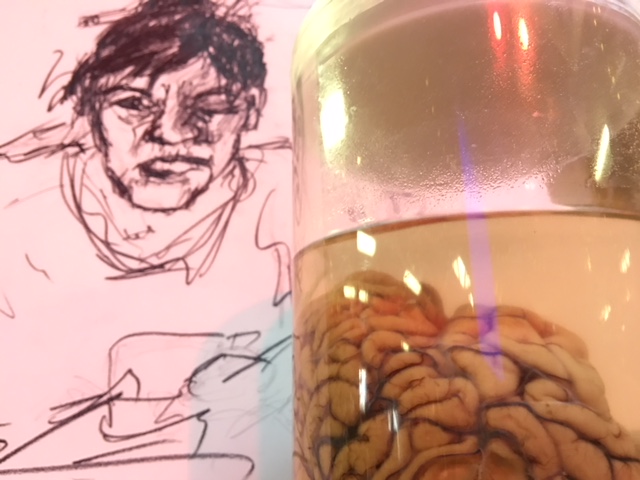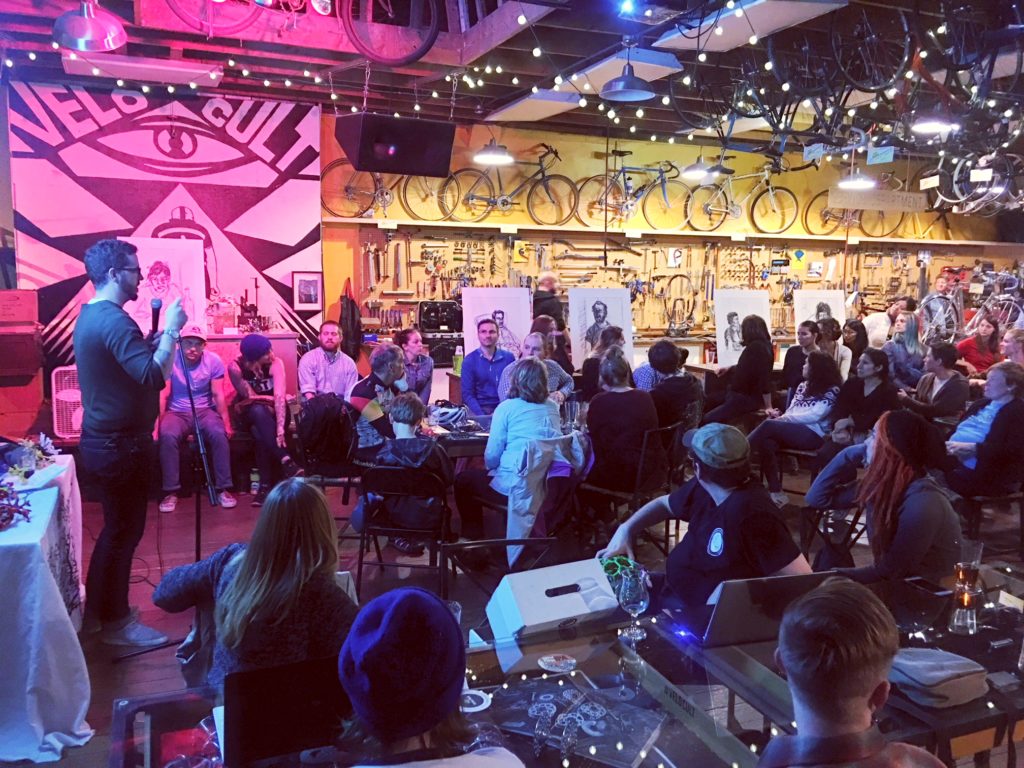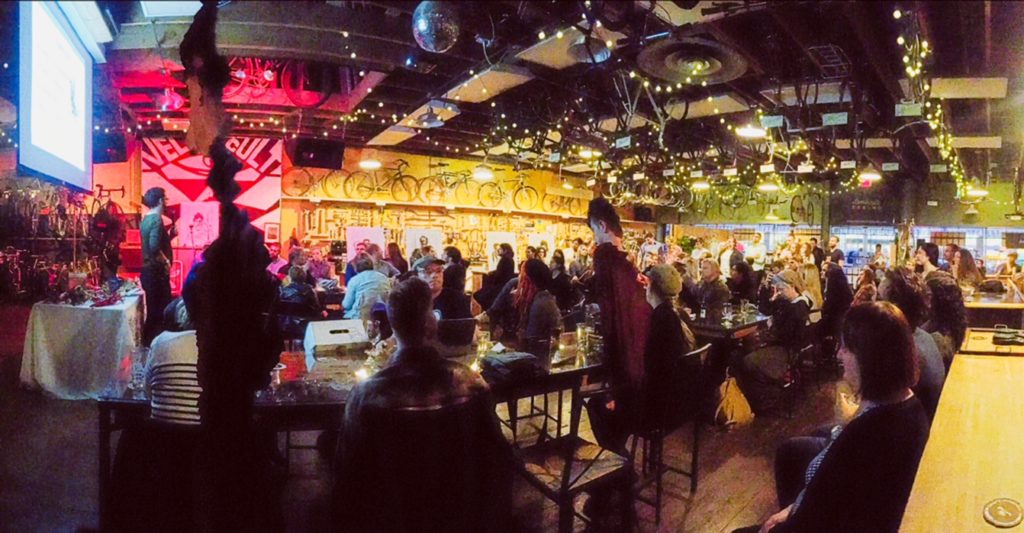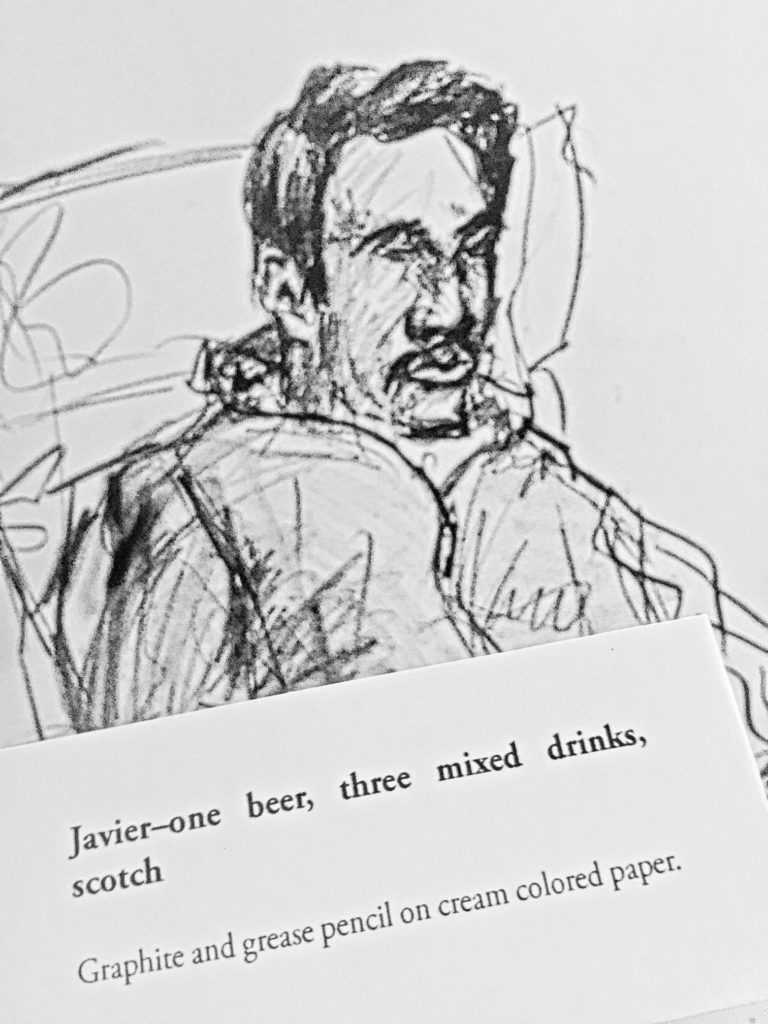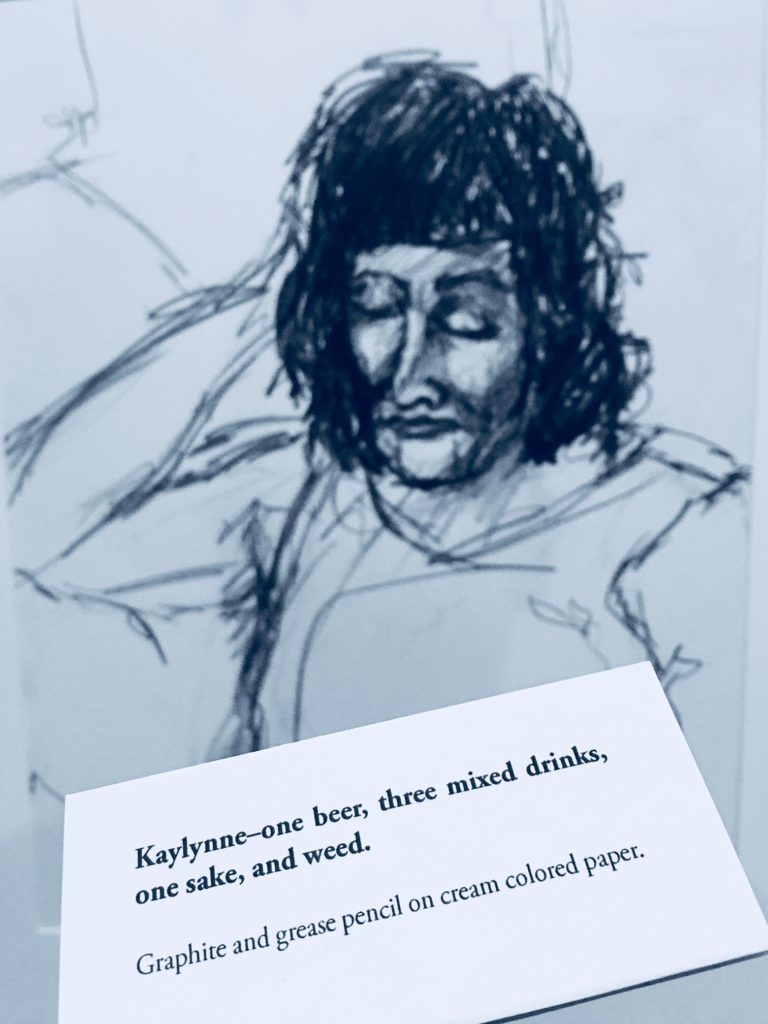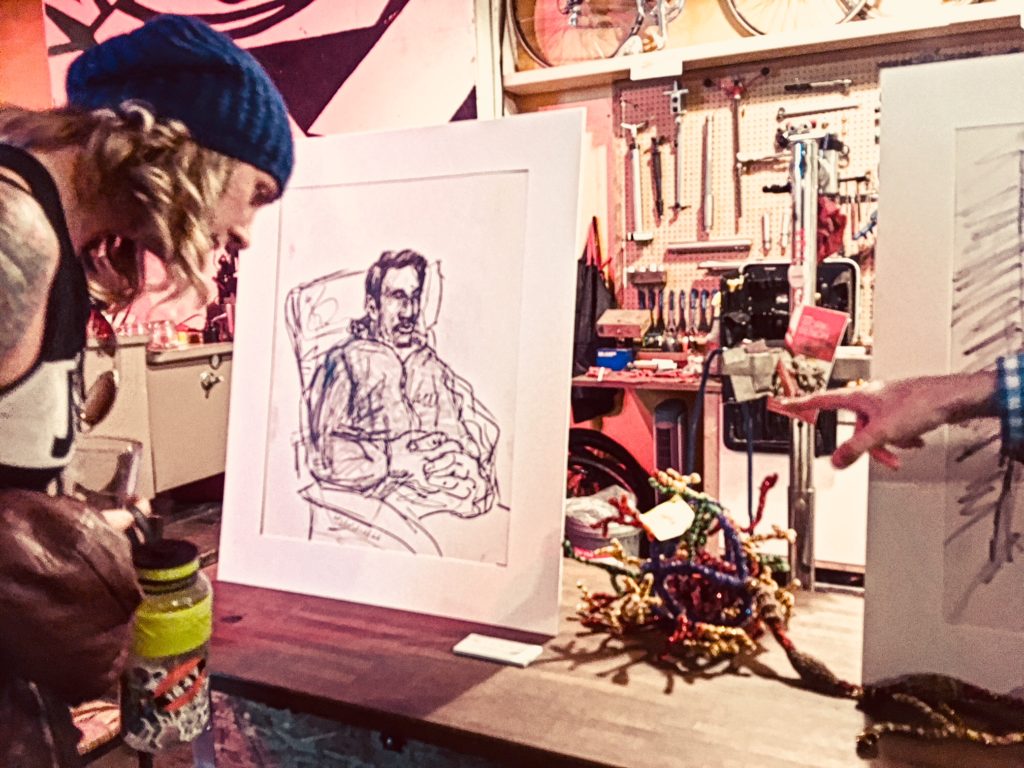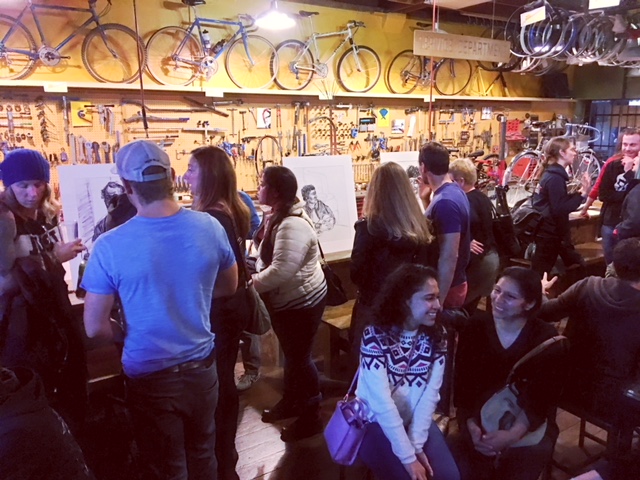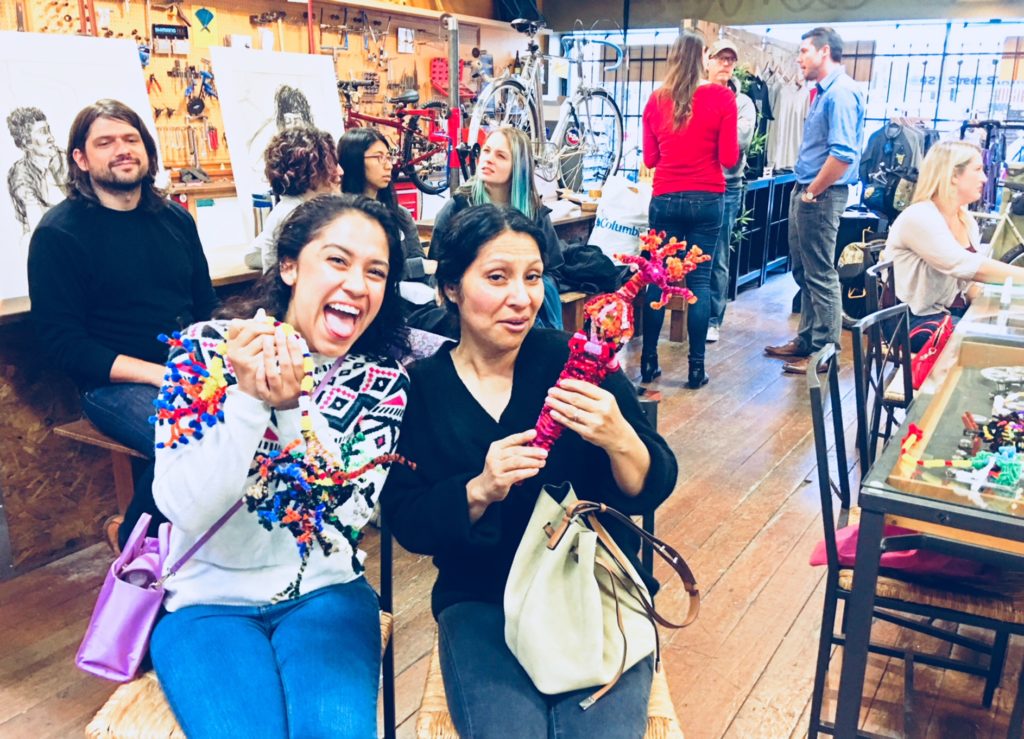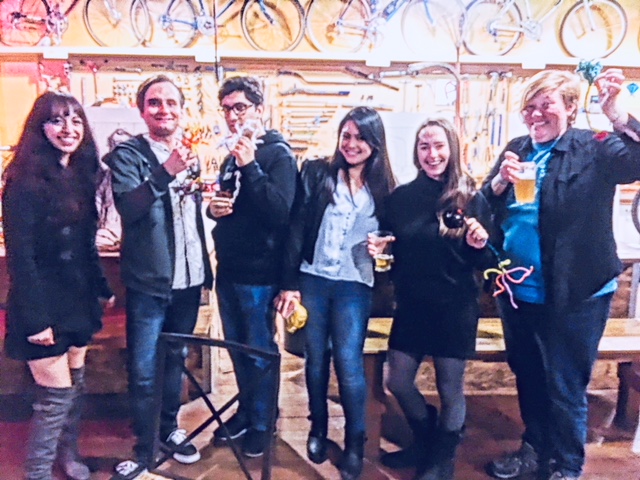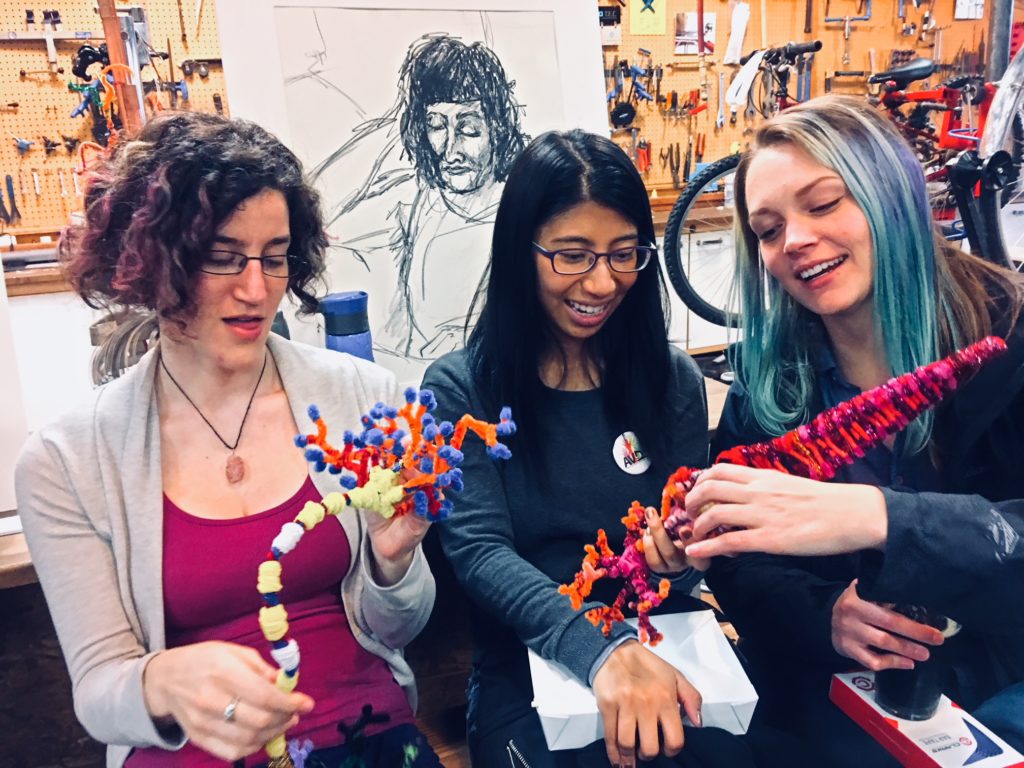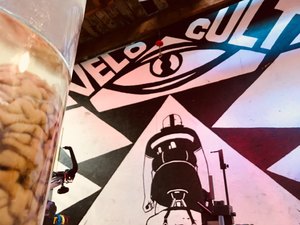Curious folk, partnered and not, streamed into our favorite, world-renowned Portland bike bar to learn what current neuroscience research – and art – suggest about alcohol’s effects on social relationships…
Our velocipedal venue offers extensive opportunities to explore the role of this popular drug (an array of quality craft beer is always on tap at Velo Cult), as well as our affiliative connections with each other…
LEARN MORE: Dolores Benedict
FAVORITE INSTAGRAM COMMENT: “My first experience at VC was this!! Love, love the community!”
We gathered to hear from André Walcott, a graduate student in Behavioral Neuroscience at Oregon Health & Science University in Dr. Andre Ryabinin’s lab, and Bryn Harding, an artist, print maker and expert in portraiture, who recently graduated from the Pacific Northwest College of Art…
Dr. Ryabinin has presented at Velo Cult himself on related themes…
LEARN MORE: The Science of Six Pack @ Velo
A healthy crowd ordered pints and sat by their significant others as Noggin Brain Board member Dr. John Harkness introduced Sulema Rodriguez, our Resource Council member for the innovative NIH BUILD EXITO program at Portland State University.
Sulema described our expanding “Bring Brains Back to DC” outreach plans for the nation’s Capitol this fall! Noggin is invited to present volunteers, brains and art at the Society for Neuroscience conference, in area public schools, and before the Neuroscience & STEAM caucuses in the U.S. House of Representatives!
LEARN MORE: #brains2DC
Sulema was followed by Jesse Hamlin, our Noggin Resource Council member for music and performance from Psychology at Portland State University. Jesse, an accomplished member of the band Shannon Entropy – enthused the audience over the upcoming student-organized celebration of art, music and research known as Noggin Fest at the Alberta Rose Theater on Wednesday, October 11!
SUPPORT #sciart OUTREACH: Noggin Fest October 11th!!
André Walcott then took the mike to introduce his talk for the evening, titled “Drink Together, Stay Together: Alcohol’s Effects on Social Relationships…”
LEARN MORE: André Walcott at Velo Cult Sept. 2017 (pdf)
He began by presenting current statistics on marriage in the United States. Only one in 15 U.S. marriages lasts more than 10 years, and drinking and drug use is the third most common reason cited for divorce…
LEARN MORE: Marriage and Divorce
André also let us know that among celebrities, Mel Gibson suffered the most expensive divorce ($425 million!), while Brittany Spear’s marriage was by far the quickest at only 55 hours long…
André also related the National Institute for Alcohol & Alcoholism (NIAAA) guidelines on drinking levels, noting that “heavy,” “at risk” alcohol consumption involves more than 14 drinks/week for men, and 7 for women.
Of course it’s critical to know the definition of a “drink.”
LEARN MORE: U.S. Office of Disease Prevention/Health Promotion dietary guidelines
LEARN MORE: What’s a “drink..?” At the Newmark for beer & brains
André also noted that a discrepancy in drinking behavior, or discordant drinking, where one partner drinks far more or far less than the other, can contribute to a greater likelihood of divorce, as shown in the graph below. In contrast, couples that both drink heavily (concordant drinkers) tend to experience less risk of separation. As André noted, “alcohol can split up couples – or tie them together in co-dependence.”
LEARN MORE: Concordant and discordant alcohol, tobacco, and marijuana use as predictors of marital dissolution
LEARN MORE: Relationship-Specific Alcohol Expectancies in Couples With Concordant and Discrepant Drinking Patterns
Social relationships and drinking have a complex bond. Sometimes there are significant negative consequences, including divorce, and also marital dissatisfaction and an increased risk of intimate partner violence. Yet many people get together and drink beer, wine or whiskey, and undeniably enjoy this experience, and clearly improve their social connections with others as a result…
While André is fascinated by these intricate links between alcohol and human relationships, he works with a different mammal in the Ryabinin lab – a social, often partnered and demonstrably adorable creature known as the prairie vole…
LEARN MORE: Prairie voles as a novel model of socially-facilitated excessive drinking
Prairie voles are – unlike 97% of mammals – socially monogamous, pairing up and bonding after mating, typically for life. However, they share the tendency of some similarly monogamous human couples to stray sexually, and engage in opportunistic infidelity should a new vole appear.
In contrast, a related animal known as the meadow vole is notoriously promiscuous, mating with multiple partners and spending most of its time alone, as a confirmed bachelor!
Interestingly, monogamous prairie voles express many receptors for a neurochemical known as oxytocin in specific areas of the brain, including the nucleus accumbens, that are critical for motivated behavior and the expectation of reward. Transgenic female prairie voles which overexpress oxytocin receptors in the accumbens will actually pair bond more quickly after mating..! Male meadow voles, in contrast, have far fewer oxytocin receptors in this brain region (they have more in a different area, the lateral septum), and they are promiscuous, and spend a lot more time alone.
LEARN MORE: What Can Rodents Tell Us About Why Humans Love?
LEARN MORE: Neurophilosophy @ the Newmark
Prairie voles also seriously LOVE alcohol, with some consuming the equivalent of multiple bottles of wine each day, if given the opportunity! Yet as in humans, there is diversity in drinking. And also as in humans, how much each vole drinks individually may affects a couple’s relationship…
Alison Anacker and her colleagues, for example, found that female prairie voles would huddle more with their partner after drinking alcohol, taken as a behavioral measure of increased bonding. In contrast, tipsy males were much more likely to pursue a little opportunistic infidelity if a strange vole were around!
LEARN MORE: Drinking alcohol has sex-dependent effects on pair bond formation in prairie voles
We noticed several in the audience rolling their eyes, as if they knew a few of these male voles…
FROM SCIENCE NO LESS: Alcohol Makes Prairie Voles Sleep Around
André is curious about how alcohol affects various aspects of the pair bond between monogamous voles, including the formation of the bond during mating, and the maintenance of the bond afterwards. Sober pair bonded males often aggressively reject stranger females, and research has revealed that this behavior is partly mediated by specific opioid receptors in one part (the shell) of the nucleus accumbens…
LEARN MORE: κ-Opioid receptors within the nucleus accumbens shell mediate pair bond maintenance
This selective aggression towards female strangers also involves another neurochemical, vasopressin, which is increased in the anterior hypothalamus in these socially monogamous pair-bonded male voles…
LEARN MORE: Anterior hypothalamic vasopressin regulates pair-bonding and drug-induced aggression in a monogamous rodent
Unsurprisingly, pair bonding in prairie voles (and undoubtedly humans) involves complex neurocircuitry, and changes in multiple neurotransmitters and hormones. One interesting region, with diverse behavioral roles, is the brainstem’s periacqueductal gray (PAG). Alcohol has multiple actions and effects on PAG neurochemicals, including opioids…
André explored the selective activation of the PAG in his prairie voles by examining FosB, a gene that reliably ramps up expression following repeated drug exposure. Administering alcohol activates certain neurons, which promotes FosB expression, which results in increased production of the FosB protein. These intracellular events occur on a consistent timescale, and are measurable…
EXPLORE MORE: Molecular neurobiology of addiction: what’s all the (Δ)FosB about?
EXPLORE MORE: Repeated alcohol administration differentially affects c-Fos and FosB protein immunoreactivity in DBA/2J mice
So far he’s discovered that the PAG responds differentially to concordant or discordant drinking in pair bonded prairie vole males (he’s looking at the females next), further indicating a role for this region of the brainstem in the interaction between alcohol and social relations…
As we sipped our beverages and enjoyed each other’s company, Bryn Harding took the stage to discuss the portraits he’d created while collaborating with André. Many people, he suggested, aren’t that interested in portraits – they’re considered “old and boring” – but he’s fascinated by how they capture something essential about a relationship, after sitting with someone over time…
“Identities are like ecosystems,” said Bryn, “and I was curious to see if and how those ecosystems might be influenced by drugs and alcohol.” Bryn also wanted his portraits to exist in the larger context of a strong relationship, so he invited people he knew well to make a night of it – “drinking, watching Netflix, telling stories” – and portraiture!
LEARN MORE: A portrait is a representation of a particular person (Tate Gallery)
Bryn worked with grease pencils, used for making long-lasting marks on lithography stones, and also for writing the names of chemicals on glass containers in some labs. He chose this particular tool because there is absolutely no way to erase the marks, and he wanted his portraits to record the relationship he experienced under the influence of alcohol (and in some cases, a few cannabinoids)…
LEARN MORE: Lithography 101
“I enjoy how much of the thinking process you can see that went into the drawings,” reflected Bryn, as his introduced us to his evocative work. He waxed rhapsodically about lines, and the tremendous amount of information they embody…
From Bryn: “Why do I love lines so much? A line is a way of describing a 3D thing in 2D – and it is intimately involved with our bodies – the velocity, speed, pressure. You can see how an artist engaged with an arm, or a shoulder. Were they fast and careless? Slow and deliberate? You can extract from lines something about how both the artist and the subject felt…”
“Lines tell interesting stories…” And drinking, said Bryn, and sometimes weed, contributed to the relationships captured by these portraits. He did not always like the results, but he was intrigued and curious. “Changing our states of mind changes how we see things,” he explained. “We see differently under the influence of these substances, but it’s not necessarily better.” It’s a change in the ecosystem.
Andrew – between five and seven glasses of wine, weed and two beers
“I don’t trust photographs,” Bryn added. “I think they give us the illusion of understanding without real understanding, and they capture only milliseconds.” Each portrait, in contrast, derives from a relationship forged and changed and explored over an entire evening…
Carla – lots of weed
Everyone then had a chance to ask questions of André and Bryn, contemplate our own cerebral ecosystems, consider compelling explorations into their nature via neuroscience research and art – and view the rich portraits (and stories) on display…
Many thanks to André and Bryn – and to Velo Cult for hosting another popular #sciart event!





